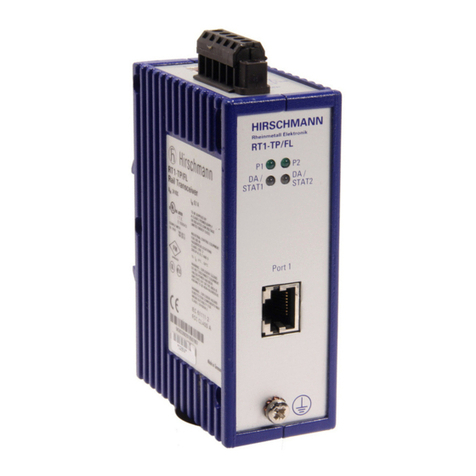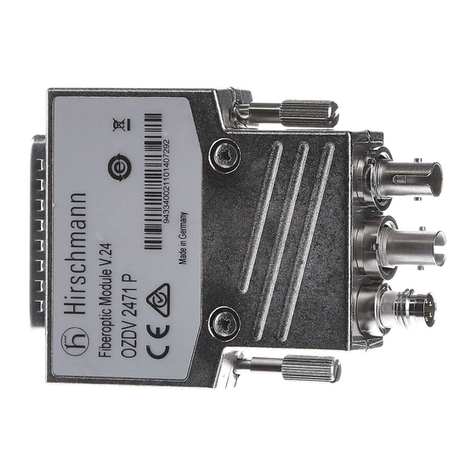2
Inbetriebnahme
Betriebsarteneinstellungen
Überprüfen und korrigieren Sie bei Bedarf
folgende Einstellungen:
– Umschaltung „für DTE/für DCE”-Betrieb
– Verbindung Schirmmasse mit Signalmasse
– Wahl der Spannungsversorgung.
Umschaltung „für DTE/für DCE”-Betrieb
Je nach Erfordernis des angeschlossenen
Endgerätes können Sie mit den Schiebe-
schaltern S1(braun) und S2(rot) zwischen
„für DTE”- und „für DCE”-Betrieb umschalten.
(Informationen hierzu finden Sie im Handbuch
des anzuschließenden Endgerätes.)
Schieben Sie zum Umschalten die
Schiebeschalter mit einem spitzen
Gegenstand in die entsprechende Stellung.
„für DTE”-Betrieb
(werkseitig eingestellt)
„für DCE”-Betrieb
Verbindung Schirmmasse mit Signal-
masse
Bei Bedarf können Sie die Schirmmasse (Pin
1 des 25poligen Sub-D Steckverbinders) mit
der
Signalmasse/Spannungsversorgungsmasse
(Pin 7) mit dem Schiebeschalter S3(orange)
galvanisch verbinden.
Schieben Sie zum Umschalten den
Schiebeschalter mit einem spitzen
Gegenstand in die entsprechende Stellung.
Pin 1 und Pin 7 getrennt
(werkseitig eingestellt)
Pin 1 und Pin 7 verbunden
Wahl der Spannungsversorgung
Wünschen Sie statt der
Spannungsversorgung über ein
Steckernetzteil eine Spannungsversorgung
vom angeschlossenen Endgerät über den
25poligen Sub-D-Steckverbinder (Pin 11), so
ist dies durch Umschalten von
Schiebeschalter S4(gelb) möglich.
Schieben Sie zum Umschalten den
Schiebeschalter mit einem spitzen
Gegenstand in die entsprechende Stellung.
Spannungsversorgung
über Steckernetzteil
(werkseitig eingestellt)
Spannungsversorgung
über Pin 11
LWL-Kabelverbindung
Verbinden Sie die beiden Schnittstellen-
wandler durch ein Duplex-LWL Kabel mit
BFOC (ST®) Steckverbindern.
Achten Sie bitte darauf, daß jeweils ein
Eingang (IN) und ein Ausgang (OUT) miteinan-
der verbunden sind („Überkreuzverbindung“).
Aufstecken
Stecken Sie den 25 poligen Sub-D
Steckverbinder (male) des
Schnittstellenwandlers auf den entsprechen-
den Anschluß am Endgerät und arretieren Sie
ihn mit den beiden Rändelschrauben.
Betriebsstörungen
In folgenden Störungsfällen gehen die elektri-
schen Ausgänge der Schnittstellenwandler in
den High Pegel:
– Zweiter Schnittstellenwandler nicht auf
Endgerät gesteckt;
– Zweites Endgerät ausgeschaltet.
Sind die optischen Steckverbinder am
Schnittstellenwandler OZDV 2471 P/G nicht
gesteckt, so kann – insbesondere bei hoher
Umgebungshelligkeit – ein rein zufälliges
Signal an den elektrischen Ausgängen anlie-
gen.
Zubehör
Steckernetzteil SNT 510
Bestell-Nr. 268 109-001
Beschreibung
Eine Übertragungsstrecke, bestehend aus
zwei Schnittstellenwandlern OZDV 2471 P
oder OZDV 2471 G und einem Duplex-Licht-
wellenleiter, ermöglicht eine störsichere, op-
tische Datenübertragung von V.24 (RS-232 D)
Signalen über eine Entfernung von bis zu
6700 m.
Die Übertragungsstrecke arbeitet im asyn-
chronen Vollduplex-Betrieb. Sie ersetzt alle
konventionellen Vierdraht-Verbindungslei-
tungen. Die Datenübertragung erfolgt über
zwei optische Fasern, somit müssen die ange-
schlossenen Endgeräte für Software-Hand-
shake (X on/X off-Übertragung) geeignet sein.
Dies ist in den jeweiligen Handbüchern der
anzuschließenden Endgeräte angegeben.
Der mechanische Aufbau der Schnittstellen-
wandler erfolgt als kompakte 25polige Sub-D
Steckverbinder, die die gesamte Elektronik
enthalten.
Die Spannungsversorgung der Schnittstellen-
wandler erfolgt wahlweise durch das ange-
schlossene Endgerät über den Sub-D-
Steckverbinder oder über ein Steckernetzteil.
Die Schnittstellenwandler sind sowohl „für
DTE“- (Data Terminal Equipment) als auch „für
DCE“- (Data Communication Equipment)
Betrieb geeignet. Durch einen Schiebeschalter
sind sie auf den jeweiligen Betriebszustand
des anzuschließenden Endgerätes (siehe
Handbuch) einstellbar.
Durch eine vollständige DC-Kopplung der
Schnittstellenwandler ist gewährleistet, daß
sofort beim Einschalten der Endgeräte der
richtige Zustand übertragen wird und beliebig
lange Übertragungspausen problemlos mög-
lich sind.
Durch einen Schiebeschalter kann die Schirm-
masse mit der Signalmasse verbunden werden.

























